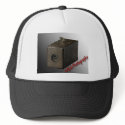 Stumble It!
Stumble It!
Recently I have been mulling around what makes a great shot. And when I start thinking like this, my mind spinning around all of the possibilities, my first thought is the rule of thirds.
In its most basic concept, the rule of thirds is a grid divided in thirds, and the idea is to place objects of eye interest on the intersecting lines - almost like playing tic tac toe, but at the intersections. And slam, bam, you are supposed to end up with a great picture.
But before you thank your mama, let's take a harder look at the rule of thirds. Start thinking of the rule of thirds as a 3-D adventure. Lay that grid down in your mind and start thinking foreground, mid-ground, and far-ground. You want to lead the eye through the picture. This is your goal. A trick I often use is to have something close of interest and something that draws the eye to the mid-field. Then, for the kicker, have something in the horizon that continues to draw interest. When I take a picture, I generally compose it as fast as I can click the shutter with these elements in mind.
And still this scratches only the technical aspects of composition. And the rule of thirds is a rule I break often. But the rule of thirds is classical, and means class. And if you follow the above simple formula, you will start to learn where and how to break the rules.
Look at the picture above. It is not in perfect alignment with the rule of thirds, but it follows one of the most important concepts. It leads the eye. Every time I look at a photo I think, what is leading my eye? I think of this in several different ways: light, shadow, colors, objects and direction. All of these elements are in my mindful consideration when I either take a photo myself or look at artful photography from another photographer.
Other things to consider when taking a photo:
Leading lines
What is the story?
Impact with visual, emotional, or mysterious elements
Diagonal elements
Vanishing points
Perspectives that are different
What a picture will evoke in the viewer
Each of these topics I will cover in later posts. But if you are like me, you will start thinking of all the possibilities now.
All of these elements work their way into making a good photograph. Below are my personal thoughts on the picture I used to illustrate this article.
The photo was taken with a Cannon elph sd750. It was the third shot I took with the camera while testing it out. I won this camera in a photo contest and I think it will make a great pocket camera. It's cheap and fun, and I also think that it proves the point that you can take a good picture with any camera at your disposal. And that is the point of this paragraph - you don't need an expensive camera to take a good shot.
Now about the compositional elements:
My friend is smack in the foreground with good play of light and shadows. The window frames the road and leads the eye directly to the mid-ground of the road. In the far-ground, a white sign leads the eye into the distance. Since my friend is looking forward, I left plenty of space so you can imagine the road ahead. I like the idea that he is squinting. It makes you feel his concentration. One other note - there is a diagonal line of interest from the end of his nose to the sign, and, off in the far distance, a barely-seen light pole. Now, you might like or dislike this shot, but I thought it would be a good photo to illustrate the points of how I use composition.
I know my mama thanks me.















No comments:
Post a Comment